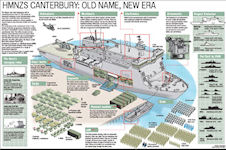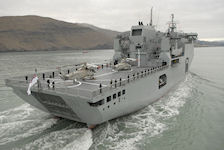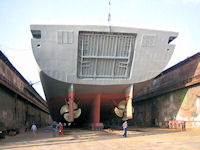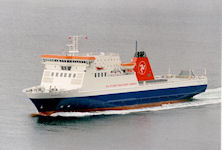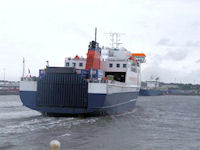HMNZS Canterbury - Sealift and Amphibious Support Vessel
The Sealift and Amphibious Support Vessel CANTERBURY is the biggest revolution for the New Zealand Navy since it was established in 1941. She is the first of seven new ships built for the Royal New Zealand Navy under Project Protector. She is affiliated to the Canterbury Region. She was built at the Merwede Shipyard in the Netherlands, under contract to Tenix (now BAE Systems Australia). CANTERBURY's design is based on a commercial RO-RO ship, Ben-My-Chree in operation in the Irish Sea. CANTERBURY has a diesel-electric propulsion and a maximum speed of just over 19 knots. She provides a sealift capability for the transport and deployment of equipment, vehicles and personnel, and is capable of transferring cargo and personnel ashore in benign conditions (up to sea state 3) when port facilities are not available. CANTERBURY has two 59 tonne Landing Craft Medium (LCM) capable of carrying 50 tonnes at 9 knots with a range of 250 nm.
The NH90 Helicopter has been selected as the NZDF's preferred medium Utility Helicopter to replace RNZAF'S Iroquois. Up to four NH90's can be carried onboard the MRV for deployment ashore in support of Army operations and disaster relief activities. The MRV is also capable of operating the SH-2G Seasprite and the helicopter deck is able to handle a Chinook-size helicopter.
HMNZS CANTERBURY was accepted by the Ministry of Defence from Tenix on 31 May 2007 and commissioned into the RNZN on the same day. After taking delivery of the HMNZS CANTERBURY two significant incidents involving the vessel resulted in Courts of Inquiry being established. The first involved the loss of a rigid hull inflatable boat (RHIB) at sea on 10 July 2007, and the second the death of a crew member on 5 October 2007 during a manoeuvre at sea to deploy a RHIB. On 20 December 2007, the Minister of Defence, the Hon Phil Goff, announced that the Secretary of Defence and the Chief of Defence Force were commissioning an independent review, on his instructions, into the ship's acquisition and introduction into service. The Report of the Review of the Safety and Functionality of HMNZS Canterbury by Mr. John Coles CB FR Eng was released 12 September 2008.
The requirements for the Protector fleet were identified in the 2000 Sealift Review and the 2002 Maritime Forces Review. The Ministry of Defence issued and considered industry responses to an invitation to register in 2002. It then called for and evaluated detailed requests for proposals through 2003 and early 2004. HMNZS CANTERBURY's acquisition was constrained by the initial choice of ship design; it has been managed to get the ship into service as soon as possible, and it has been characterised by shortcomings in project management and governance and collective wishful thinking. It is unlikely to meet all of the requirements of the contract.
From the outset of the project, there was insufficient appreciation of the constraints to the ship's operations imposed by the selection of a commercial Ro-Ro design as the basis of the design for the MRV. This was at the root of differences of opinion between the Tenix, MoD and NZDF and the subsequent shortfalls in performance. HMNZS CANTERBURY is intrinsically safe but remedial work will be required to enable her to perform military functions; some operating limitations will also have to be accepted. Sea keeping performance is likely to be poor in higher sea states.
The Tenix proposal for the MRV is based on the Ro-Ro Ferry Ben my Chree. Tenix placed a sub-contract for design and manufacture of the MRV with Merwede B.V. in the Netherlands who also manufactured the Ben my Chree. The Ben my Chree is a 'short/fat' ship that operates across the Irish Sea where conditions are akin to coastal waters, where the seas are generally short crested as compared with deep oceans. Even a cursory examination of her design and operating profile should have raised questions over her suitability, once modified, for long operational patrols in the Southern Oceans. It is axiomatic that the hull form of a ship designed for short sea crossings may not be ideally suited as a solution to fulfil the full Functional Performance Specification1 for the MRV. While the MoD's technical evaluation of the Tenix proposal for the MRV identified a number of concerns associated with the design, it did not recognise that the behaviour of the ship in a seaway was already predetermined. The technical evaluation team judged the Tenix proposal to be "medium risk" and thus it is surprising that the team did not visit the Ben my Chree and improve its understanding of the design being offered.
The MRV's sea boats are located in open alcoves port and starboard, some three meters above the waterline and about three quarters of the ship's length from the bow. Sea boats in such a position would be vulnerable to damage from the ingress and exit of green seas whenever the ship was operating in higher sea states. In general, ships' boats are whenever possible located amidships and as far away from the waterline as practical and rarely in alcoves. The reasons are obvious - amidships to limit the effect of pitch during launching/recovery operations, well above the waterline to avoid the ever present possibility of boats being washed away under extreme weather conditions and not in an alcove because in addition to initial shipping of green seas over the boats, a backwash will be generated when trapped green water exits the alcove as the sea falls away, thus increasing the risk of damage or loss of the sea boats. It is very surprising that remedial action was not taken to re-site the boats during design development, or if that proved impractical to provide some physical protection for the alcove opening and hence the sea boats.
In the case of the MRV, while operating in higher sea states (greater than Beaufort scale 8) and dependent upon speed and heading, extreme pitching and heeling will occur, leading to partial or complete propeller emergence in excess of recognised (NATO) standards. In such circumstances one or both main engines could trip and depending on generator configuration, electrical power could be lost at the same time, and hence potentially cause broaching [veer or yaw dangerously so as to lie broadside to the waves. Broaching can capsize even a large ship].
Concern about sea keeping dominated the acquisition of the MRV after contract award. In February 2005, a matter of months after the contract had been placed, serious concerns about the dynamic behaviour of the MRV in high sea states began to emerge. The contract between Tenix and the MoD was suspended on 24 March 05 and then lifted on 17 May 05 following acceptance by the MoD of Tenix's remedial plans - including that for additional data on sea keeping. The tank testing, undertaken by the Maritime Research Institute Netherlands (MARIN), took place in November 05. The results were published in February 06. The MARIN tests did not produce a materially different result to simulations although they did highlight the risk of water ingress into the alcoves and the potential risk of sea boat damage.
The program was managed with relentless determination to deliver to time despite evidence of likely performance shortfalls. There was, however, no explicit consideration of the risks of doing so. The complexity and challenges of the program were under-estimated in all respects. The project team lacked the size and range of skills to manage a project of the complexity of HMNZS CANTERBURY. Production got ahead of design from an early stage. Steel was cut in mid-April 05 - probably because of production pressures in Merwede - during the period of contract suspension. The decision to lift the contract suspension in May 05, despite unresolved issues on the MRV's sea keeping characteristics, was critical in enabling production to continue.
To improve the functionality of the vessel additional ballast should be added to the ship to reduce vertical accelerations, and arrangements for ballasting the ship should be incorporated to maintain its design draught when lightly loaded. The functionality required by the NZDF has or will be achieved. HMNZS CANTERBURY will, following remedial work as outlined elsewhere, be able to discharge all her operational roles as required in the FPS. The ship will exhibit poor sea keeping qualities for ocean patrolling in the higher sea states but, over time, the RNZN should be able to develop practices and procedure to accommodate the sea keeping performance.
It is probably not possible to operate the current ship to shore transfer system much beyond sea state 2. Considerable limitations will need to apply for safe operation of the Ship to Shore Transfer system relative to the contract requirements. The rear door/stern ramp of a ferry or the MRV serves both as a watertight barrier and a ramp across which cargo may be loaded or unloaded. For a ferry, such operations are undertaken whilst the ship is berthed with the ramp accurately positioned onto a firmly secured pontoon. For the MRV, the rear door also acts as watertight barrier but for unloading or loading operations, in the absence of fixed shore facilities, it will be open while the ship is underway. The ship to shore transfer system requires the Landing Craft (Medium) (LCM) to lower its bow ramp on to the lowered rear door - forming a continuous roadway permitting cargo to be transferred from the MRV to the LCM while underway. There will be unpredictable dynamic movement of the two hulls dependant on the sea state and changes in the displacement of the LCM as it is progressively loaded.
| Displacement: | 9000 tonnes |
| Length overall: | 131 metres |
| Beam: | 23.4 metres |
| Speed: | 19 knots |
| Complement: Total: | 360 |
| Core ship's company: | 53 |
| Flight personnel: | 10 |
| Government agencies: | 4 |
| Army ship's staff: | 7 |
| Trainees: | 35 |
| Troops: | 250 |
| Propulsion: | Diesel engines |
| Flight deck: | Space for two helicopters |
| Armament: | one 25mm two .50 calibre machine guns |


|
NEWSLETTER
|
| Join the GlobalSecurity.org mailing list |
|
|
|


